When you use an output transformer, you have a very real anode resistor: the secondary load times the transformer ratio. This is basic.
Jan
Jan
Different tubes can have hot spots in different positions on their envelopes, or the tubes have different internal structures that alter heat distribution. Best approach is to read the cathode current and use that to set the current.Not sure of your whole procedure, but offhand sounds like a bad idea as you have multiple sources of heat dissipation including heaters in an IDH power tube.
The few ohms a audio presents is not an anode resistor.When you use an output transformer, you have a very real anode resistor: the secondary load times the transformer ratio. This is basic.
Jan
As you mentioned, the name 'transformer' should be a giveaway. 😎Actually, I'd say what we now call a transformer is really no more than two wirewound resistors sitting on top of a magnet. If there were just one of them, we'd call it a choke.
Faraday invented the "transformer" in 1831. He called his invention "an induction coil". The term "transformer" only came into common usage much later in 1833 and is derived from the French.
The OP also seems to have missed post # 36, but it is not uncommon for people to 'miss' info that unmasks their own beliefs...
Jan
Feel free to explain what you believe the benefit is for doing this is. So far the consensus is that there is no advantage.I used to match power tubes in an amplifier by measuring the tube operating temperature. It takes a large lot of tubes, but same tube dissipation with same operating bias point and same tube gain is matched to me.
Last edited:
Bad idea. Transformers have huge inductance, resistors not. Transformer is not a resistor.
An anode load can be resistive or inductive. Your speaker's impedance is typically but a few ohms. When it is connected to the secondaries of an output transformer, the primaries typically have a much greater inductive load. The output transformer is performing an electrical 'transformation'.
Also, the anode load is in parallel with the internal resistance of the tube. This is something that many people have a hard time appreciating. It has implications for the electrical performance of the tube in any given circuit.
In any case, this is all irrelevant to the topic of thermally evaluating tubes for the purpose of matching them. If you can explain the electrical value in this, it would be most appreciated.
Perhaps you are concerned that the tubes will not age at the same rate if they run at different temperatures? I hate to be the one to tell you this, but there has been little proof that static operating temperature predicts aging of tubes (assuming they are run well within their limits).
Some tubes are designed to run 10'000 hrs. - even if they run 'hot'.
I do not believe he actually did it. With all the spread in tube parameters, trying to find a pair (quad?) that have the same temp, same bias and same gain would require thousands of tubes, and for each tube he would have to check that indeed the bias is the same when the temp is the same, and then make sure the gain is the same.Feel free to explain what you believe the benefit is for doing this is. So far the consensus is that there is no advantage.
Apart from the fact that no two temp measurements will be the same due to differences in internal tube state and construction and varying external measuring conditions.
It's just an idea that seemed good at the time but has been thouroughly debunked.
It never happened.
Jan
I suggest to match tubes by their weight.
I have a laser guided temp gun. I find it reliable for determining the temperature of a black heat sink and for determining the approximate temp of a large TO247 MOSFET that's bolted to that heat sink. Due to the uncertain emissivity of a tube's plate and the transmissivity of the curved glass the IR must go through, I find it rather useless for most tube measurements. Nevertheless, I have a guitar amp that I made 13 years ago dissected on the bench for repair, so I fired it up and collected a bunch of random numbers.
It would appear that the tube on the right is hotter on the top, but the tube on the left is hotter on the side of the plate, So will the real hot tube identify itself. This amp is cathode biased with a shared resistor, so both tubes get the same VOLTAGES. The actual cathode currents are unknown. The tubes are UL84's / 45B5 which are 6CW5's with a 45 volt 100 mA heater.
Note that the readings from the tops of the tubes are the lowest and most random. This may be different with flatter clear top tubes. I may or may not decide to point the gun at the UNSET board when I get it back on the bench. It currently has some clear top 6AV5GA's in it which are being run at nearly twice the published dissipation ratings.
It would appear that the tube on the right is hotter on the top, but the tube on the left is hotter on the side of the plate, So will the real hot tube identify itself. This amp is cathode biased with a shared resistor, so both tubes get the same VOLTAGES. The actual cathode currents are unknown. The tubes are UL84's / 45B5 which are 6CW5's with a 45 volt 100 mA heater.
Note that the readings from the tops of the tubes are the lowest and most random. This may be different with flatter clear top tubes. I may or may not decide to point the gun at the UNSET board when I get it back on the bench. It currently has some clear top 6AV5GA's in it which are being run at nearly twice the published dissipation ratings.
Attachments
-
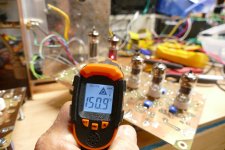 P4020810.JPG302.7 KB · Views: 52
P4020810.JPG302.7 KB · Views: 52 -
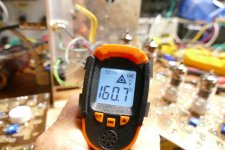 P4020811.JPG273.6 KB · Views: 50
P4020811.JPG273.6 KB · Views: 50 -
 P4020812.JPG319.4 KB · Views: 47
P4020812.JPG319.4 KB · Views: 47 -
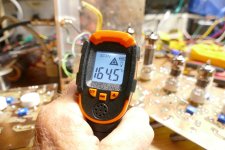 P4020813.JPG296.3 KB · Views: 51
P4020813.JPG296.3 KB · Views: 51 -
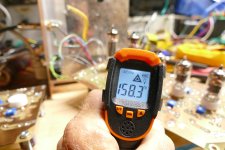 P4020814.JPG310.2 KB · Views: 48
P4020814.JPG310.2 KB · Views: 48 -
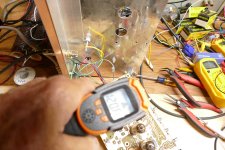 P4020815.JPG400.3 KB · Views: 51
P4020815.JPG400.3 KB · Views: 51 -
 P4020816.JPG405 KB · Views: 48
P4020816.JPG405 KB · Views: 48 -
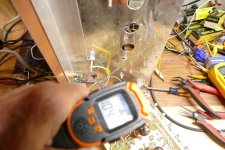 P4020817.JPG352.2 KB · Views: 44
P4020817.JPG352.2 KB · Views: 44 -
 P4020818.JPG441.9 KB · Views: 49
P4020818.JPG441.9 KB · Views: 49 -
 P4020819.JPG424.5 KB · Views: 48
P4020819.JPG424.5 KB · Views: 48
George, most of the parts I use would have released the magic smoke at those temperatures.
Tubes are crazy 😎
Many thanks for this - finally someone who actually provides data!
Jan
Tubes are crazy 😎
Many thanks for this - finally someone who actually provides data!
Jan
Since the numbers vary by at least 10 C in repeated trigger pulls while hand holding the gun, it looks like clamping the gun and circuit board such that no movement occurs may improve repeatability. Testing all tubes in the same socket is required, but physical differences from tube to tube will likely still be a major error source.
There's also a bit of a philosophical factor involved:
Question: what actually is 'the temperature' of a tube?
Answer: it is what I measure at a single point in space from an inch or so away.
Jan
Question: what actually is 'the temperature' of a tube?
Answer: it is what I measure at a single point in space from an inch or so away.
Jan
I've used my IR gun like this for curiosity and find getting repeatable temps from the same tube very difficult. The problem is the absolute distance and area has to be perfect. My thermometer has a 1:8 spot area/distance averaging sensor. If you are holding it by hand you must be very steady and at the exact same distance on every trigger pull. The laser pointer helps but that thing gets reflected and is hard to be certain it's hitting the same spot and then there is a period of computation delay that takes place also. If you are a small difference in distance between trigger pulls you get a larger or smaller target area that gets averaged. So if you want to use the IR gun to weed out obviously over or under dissipation, to find which tube in a common cathode resistor pair or group you have, it could be a tool for that, but you also have to keep in mind that the hot tube may be the good tube that is carrying the load for its weak partners. Then you have to check each grid for leakage, too. And the whole idea of the value of ''matching'' is generally poorly understood by most casual DIYers. Too many have a tunnel vision focus on perfection and uniformity to give a tube a break.
The IR gun attempts to guess the temperature of a solid object by measuring its IR radiation over a certain area of the IR spectrum. The numbers generated in this particular unit ASSUME a 98% emissivity which is close for a black heat sink or a black tube plate. The glass has some obvious absorption since it gets real hot as well as some diffusion.
The non measurable errors occur inside the plate as no two tubes are identical and none are perfect. The electron streams that emerge between the beam plates do not resemble those shown in the early RCA tube manuals!
The non measurable errors occur inside the plate as no two tubes are identical and none are perfect. The electron streams that emerge between the beam plates do not resemble those shown in the early RCA tube manuals!
It appears that Tubelab (George) has been measuring temperature of tubes for years now... And in the post above he neatly demonstrates the folly in trying to even get accurate measurements with a laser guided temp gun. Please consider that Tubes have been around for 100+ years now and NOTHING you can think of had not already been considered and done. Seriously, NOTHING. It has ALL been done before. Even doing non-electrical things with them!No one tried it is all.
Ok, now that we have got that out of the way, this still does not explain what you are trying to achieve with 'heat' measurements. Please elaborate what the purpose of these measurements is (if there is one).
If there is no purpose, then I can suggest that you can also match tubes based on size and appearance. This also has no electrical significance but it might make you 'feel good'.
Last edited:
His stated view is that if two tubes have the same temp, they will have the same bias point and gain.
Jan
Jan
"temp matched tubes" should work on ebay just as good as matched pair, same batch, same date, a.s.o. 😉
- Home
- Amplifiers
- Tubes / Valves
- Matching tubes by Operating Temperature